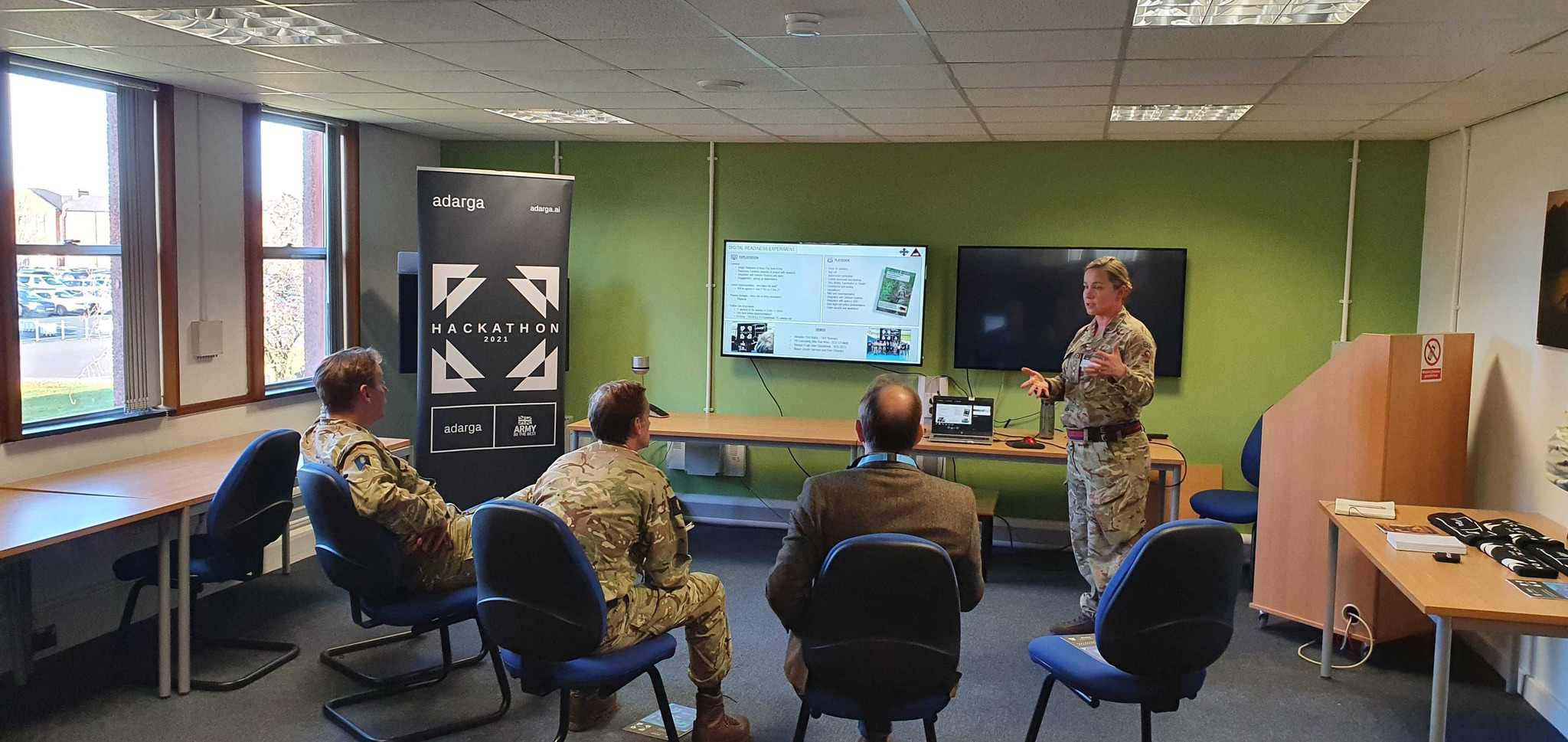British soldiers and artificial intelligence experts Adarga, have teamed up to supercharge the rapid development of key military digital tools fit for the new information age
Signalling a dramatic step-change in exploiting digital innovation, the Digital Readiness Experiment (DRE) which followed Hackathon 2021, allowed revolutionary digital solutions to real-life military problems to be developed in double-quick time and deploy for testing during 1 (UK) Division’s Exercise Rhino Charge.
The exercise saw soldiers’ experiment with seven winning concepts that had been expanded into prototype digital tools following Hackathon 2021.
“For example, we have a tool that automates the Staff Officers’ handbook yardsticks, replacing cumbersome Combat Service Support spreadsheets that calculate food, fuel and water consumption, and a tool that ingests mobile phone diagnostic data, providing crucial insights on communications planning." Captain Jordan Kemp, Digital Readiness Experiment (DRE)
Held from late November to early December, it tested the divisional staff’s planning capabilities and allowed real-time military users of the new digital tools to be supported by Adarga, and was designed to get the best digital tools needed to win in the information age.
Captain Jordan Kemp, part of the winning team at Hackathon 2020, and Project Officer for the DRE, said: “After the Hackathon we had six weeks to take the concepts and develop them into workable prototypes to deploy on Exercise Rhino Charge.
“For example, we have a tool that automates the Staff Officers’ handbook yardsticks, replacing cumbersome Combat Service Support spreadsheets that calculate food, fuel and water consumption, and a tool that ingests mobile phone diagnostic data, providing crucial insights on communications planning.
“We also have a tool that tracks casualties from the point of injury all the way through the clinical care pathway, currently all done on paper, and a 3D mapping programme that allows planners to fly through a digital twin or the area of operations in virtual reality.
Robert Bassett Cross, CEO and founder of Adarga, said Exercise Rhino Charge is evidence of the transformational pace at which the Army can exploit powerful software and AI driven capabilities.
The solutions have been designed to cut right to the heart of the critical challenges faced by soldiers on the ground, such as casualty evacuation, logistics planning, risk monitoring, situational awareness and much more, he added.
“As a British Army reservist, what I saw in the Hackathon and what I am seeing in the ongoing development phase feels strangely familiar. Diverse teams of people are working towards a shared mission with a structured process and chain of command.” Lieutenant Colonel Madeline Lewis
And, demonstrating the huge value of transferable skills between the Army and industry, was Hackathon judge and reservist officer Lieutenant Colonel (Lt Col) Madeline Lewis, Commanding Officer of an Army Reserve battalion. In her civilian role, Madeline led the development phase, getting the seven prototypes built for use in the exercise.
A reservist officer with over 22 years’ military service under her belt, Lt Col Lewis is also the Managing Director of the Defence branch of consultancy and leading project management company, Accenture. She has led on the company’s collaboration with the Defence BattleLab and is also an active member of the Army Tennis Club.
She said: “The rapid ideation environment of the Hackathon and iterative development operations (DevOps) approach that is being applied to the development of the proof of concepts is new ground for many involved.
“This approach demands a lot from participants. They need to put their ideas out there for criticism. They need to work at rapid pace to plan, develop and test their solutions to tight deadlines. And, most importantly, they need to be ready to fail.
“As a British Army reservist, what I saw in the Hackathon and what I am seeing in the ongoing development phase feels strangely familiar. Diverse teams of people are working towards a shared mission with a structured process and chain of command.”
Lt Col Lewis added that whilst development cycles in Defence can sometimes take years, this process has forced participants to focus on immediate objectives and given them the tools to deliver at pace.
“Each team has been working directly with serving military personnel to ensure that solutions are built for end users and I have seen the real excitement that the DevOps approach has created.
“This rapid cycle has shown the true power of digital for the armed forces and created real enthusiasm for what can be achieved. It has created enthusiasm for change and brought in people who may have previously felt disconnected from the whole process,” she added.
Alen Damadzic, a Product Manager at Adarga, artificial intelligence software leaders, was one of the industry partners joining forces with military colleagues to develop an AI-based tool to monitor open-source news and situation reports, providing a real-time feed of events as they unfold.
He said these events, which are automatically analysed and connected to the Army’s existing data sets by the software in order to provide full context to the user, were incorporated into route planning to help with situational awareness, all enabling military planners to rapidly respond to fast-moving situations and ultimately ensure safer journeys.
“Working directly with Army personnel really helped us to accelerate the innovation process and ensure we were addressing the mission critical problems they faced in a way that was also extendable, flexible and scalable across different operational scenarios.
“The first challenge was getting the Army staff officers and soldiers to remove the boundaries of what they believed was possible, we’ve even had Army users evangelising our AI solution for us, which really puts a smile on my face,” he added.
The Army’s Digital Readiness experiment is all about testing and learning about the digital readiness of the British Army and the First Division who have to be ready to lead operations around the world.



